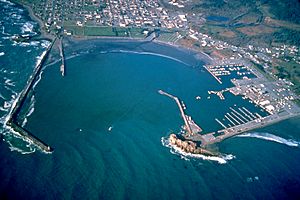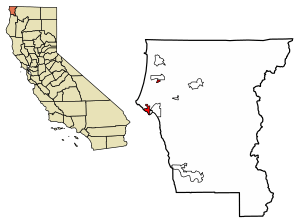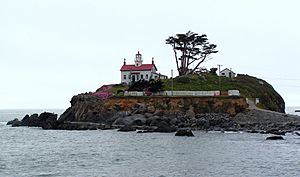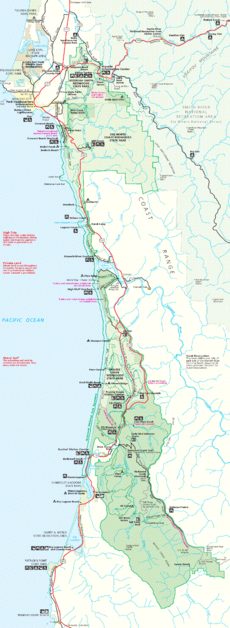Crescent City, California facts for kids
Quick facts for kids
Crescent City, California
|
||
|---|---|---|

Crescent City harbor
|
||
|
||
| Nickname(s):
The Redwood Gate to the Golden State
|
||

Location of Crescent City in Del Norte County
|
||
| Country | United States | |
| State | California | |
| County | Del Norte | |
| Incorporated | April 13, 1854 | |
| Government | ||
| • Type | Mayor/Council | |
| Area | ||
| • Total | 2.42 sq mi (6.25 km2) | |
| • Land | 1.96 sq mi (5.09 km2) | |
| • Water | 0.45 sq mi (1.17 km2) 18.7% | |
| Elevation | 43 ft (13 m) | |
| Population
(2020)
|
||
| • Total | 6,673 | |
| • Density | 3,398.7/sq mi (1,312.26/km2) | |
| Time zone | UTC-8 (Pacific) | |
| • Summer (DST) | UTC-7 (PDT) | |
| ZIP codes |
95531, 95532, 95538
|
|
| Area code | 707 | |
| FIPS code | 06-17022 | |
| GNIS feature IDs | 277494, 2410262 | |
Crescent City is a city in Del Norte County, California. It's the only city in the county and also its main government center. The city got its name from the shape of the sandy beach south of it, which looks like a crescent moon. In 2020, about 6,673 people lived here.
The city is home to the main office of Redwood National Park. You can also find the old Battery Point Lighthouse here. Crescent City Harbor is a busy place for many commercial fishing vessels. This is because the waters of the Pacific Ocean nearby are full of fish and easy to reach.
Crescent City is located on the Pacific coast in the very northwest part of California. It's about 20 miles (32 km) south of the Oregon border.
Because of how the ocean floor is shaped offshore, Crescent City is very open to tsunamis. In 1964, a huge earthquake in Anchorage, Alaska, caused four tsunami waves that destroyed much of the city. In 2011, another tsunami from an earthquake near Sendai, Japan, badly damaged the city's harbor. Waves over 8 feet (2.4 m) tall destroyed many boats and docks.
The weather in Crescent City is mild. Summers are cool because the ocean keeps temperatures down. Areas further inland, behind the mountains, have much hotter summers.
Contents
History of Crescent City
Crescent City was built on land where Tolowa Indian Settlements once stood. These settlements were near Battery Point and Pebble Beach. The Tolowa people called this place Taa-’at-dvn.
In 1855, the U.S. Congress approved building a lighthouse at Battery Point. This lighthouse is on an island that gets covered by water at high tide. It still works today and is an important historical site.
People from Europe started moving to this area in the 1850s. Crescent City officially became a city in 1854.
Ships Named Crescent City
Two ships have been named Crescent City.
- The first was a 113-ton (102-tonne) schooner built in 1848.
- Another ship, a 701-ton (636-tonne) steam schooner, was named Crescent City in 1906. It used to be called Jim Butler. This ship was wrecked near the Channel Islands in 1927.
Famous Shipwrecks
Two important shipwrecks happened off the coast of Crescent City.
- The Brother Jonathan was a paddle steamer that crashed on an unknown rock near Point St. George. This happened on July 30, 1865.
- The SS Emidio was a large oil tanker. It was the first ship hit by a Japanese submarine off California during World War II. This happened on December 20, 1941. The damaged tanker broke apart on the rocks near Crescent City. What's left of the ship is now a California Historical Landmark.
Geography and Nature
Crescent City covers about 2.4 square miles (6.25 km2). Most of this area, about 1.96 square miles (5.09 km2), is land. The rest, about 0.45 square miles (1.17 km2), is water.
The main ways people make money in Del Norte County are fishing, crabbing, tourism, and the timber business. Elk Creek flows into the Pacific Ocean right in Crescent City.
The closest large town inland is Happy Camp. It's about 42 miles (68 km) away by air, but much further by road because of the difficult land. The nearest city is Brookings, Oregon, which is about 20 miles (32 km) north along the coast. The Humboldt Bay area, with cities like Eureka and Arcata, is more than 60 miles (97 km) south.
Crescent City is as far north as cities like Chicago. It is much further north than San Diego, which is at the southern tip of California. Crescent City is actually closer to Vancouver, Canada (521 miles or 838 km), than to Los Angeles (623 miles or 1,003 km).
Climate and Weather
Crescent City has a warm-summer Mediterranean climate. This means it has mild, wet winters and warm, dry summers. The wettest months are from October to March, with December being the wettest. July is the driest month.
In December, the average high temperature is about 55°F (13°C), and the low is about 41°F (5°C). In August, the average high is about 64°F (18°C), and the low is about 53°F (12°C). It rarely gets below freezing in winter, maybe four mornings a year.
The hottest temperature ever recorded in Crescent City was 97°F (36°C) in September. The coldest was 19°F (-7°C) in January and December.
Tsunami History

The shape of the ocean floor around Crescent City makes it very vulnerable to tsunamis. Between 1933 and 2008, the city experienced tsunami conditions 31 times. Most of these were small, but some caused damage. One event is known as the "largest and most destructive recorded tsunami to strike the United States Pacific Coast."
On March 27, 1964, a huge earthquake in Anchorage, Alaska, caused a massive tsunami. The first wave reached Crescent City about four hours later, causing some flooding. The second and third waves were smaller. But the fourth wave was about 20 feet (6.1 m) high and hit after the harbor water had almost completely drained out.
The next morning, the damage was terrible. 289 buildings and businesses were destroyed. 1,000 cars and 25 large fishing boats were crushed. 12 people died, and over 100 were hurt. 30 city blocks were completely wiped out. Crescent City was hit harder than any other place on the West Coast. This was due to its location, the ocean floor shape, and nearby rivers.
Since the 1980s, the harbor's protective wall has been strengthened with huge concrete blocks called Dolos. These weigh 38 tons (34 tonnes) each.
Crescent City is now considered "tsunami-ready." This was tested on June 14, 2005, when a 7.2 magnitude earthquake hit 90 miles (145 km) offshore. A tsunami warning was issued, and about 6,000 people were evacuated. A 26-centimeter (10-inch) tsunami wave did hit the area.
On November 15, 2006, an 8.3 magnitude earthquake near the Kuril Islands in the Pacific caused another tsunami warning. Although the warning was later canceled, a surge from the quake still damaged three docks and several boats in Crescent City's harbor.
On March 11, 2011, parts of the city were evacuated after a 9.0 magnitude earthquake hit Japan. Thirty-five boats were destroyed, and the harbor was badly damaged. The highest wave surge was over 8 feet (2.4 m). One person died during this event.
Population and People
| Historical population | |||
|---|---|---|---|
| Census | Pop. | %± | |
| 1860 | 638 | — | |
| 1870 | 458 | −28.2% | |
| 1880 | 343 | −25.1% | |
| 1890 | 907 | 164.4% | |
| 1900 | 699 | −22.9% | |
| 1910 | 1,114 | 59.4% | |
| 1920 | 955 | −14.3% | |
| 1930 | 1,720 | 80.1% | |
| 1940 | 1,363 | −20.8% | |
| 1950 | 1,706 | 25.2% | |
| 1960 | 2,958 | 73.4% | |
| 1970 | 2,586 | −12.6% | |
| 1980 | 3,075 | 18.9% | |
| 1990 | 4,380 | 42.4% | |
| 2000 | 4,006 | −8.5% | |
| 2010 | 7,643 | 90.8% | |
| 2020 | 6,673 | −12.7% | |
| 2023 (est.) | 5,611 | −26.6% | |
| US Decennial Census | |||
In 2010, Crescent City had a population of 7,643 people. The city had about 3,165 people per square mile (1,222 per km2).
Most people in Crescent City were White (66.1%). There were also significant numbers of African American (11.9%), Native American (4.8%), and Asian (4.4%) residents. About 30.6% of the population identified as Hispanic or Latino.
About 53.2% of the population lived in regular homes. The rest, about 46.5%, lived in places like Pelican Bay State Prison, which is located within the city limits.
There were 1,707 households in the city. About 32.7% of these homes had children under 18. The average household had 2.38 people.
The city's population included 14.5% under 18 years old and 7.7% who were 65 or older. The average age was 34.9 years.
Education in Crescent City
The public schools in Crescent City are part of the Del Norte County Unified School District. This district includes all public schools in Del Norte County. Here are some of the schools in or near Crescent City:
- Del Norte High School is the only public high school in Crescent City. It's on the north side of town. The old high school building is now a public gym and county offices.
- Bess Maxwell Elementary School is one of the older elementary schools in the northern part of town. It serves students in grades 1–5.
- Castle Rock Charter School is a K–12 (kindergarten through 12th grade) charter school. It offers personalized education and helps parents who home school their children. It also runs the Tah-Ah-Dun American Indian Magnet School. This school helps meet the special needs of American Indian students. (Tah-Ah-Dun is the Tolowa name for Crescent City, honoring the original Tolowa village.)
- Crescent Elk Middle School is the oldest school site still operating in the city. It's in the center of Crescent City and serves grades 6–8.
- Mary Peacock Elementary School is a newer elementary school. It was built to help with the increased number of students after Pelican Bay State Prison was built, which led to more families moving to the area.
- Joe Hamilton Elementary School is a K–5 school located near Crescent Elk Middle School.
- Pine Grove Elementary School has been a K–5 school for many years. It serves the eastern part of Crescent City.
- Sunset High School is another high school in Crescent City. It also has a child care center.
Getting Around Crescent City
You can reach Crescent City by car using U.S. Route 101. This highway goes right through the city. It connects to the Oregon Coast in the north and Eureka in the south. U.S. Route 199 starts north of Crescent City and goes northeast to Grants Pass, Oregon.
For air travel, Del Norte County Airport (also called Jack McNamara Field) has flights. Currently, Advanced Air flies from Crescent City (CEC) to Oakland International Airport (OAK) and Los Angeles-Hawthorne Airport (HHR).
Local buses are provided by Redwood Coast Transit. You can also find taxi companies. Crescent City is also served by buses from Curry Public Transit and POINT.
The Crescent City Harbor is a busy place for commercial fishing. Fishermen bring in salmon, shrimp, tuna, cod, and dungeness crab. The harbor also has many businesses related to fishing and other activities. There are also docks for pleasure boats.
Fun Things to Do
Attractions
- In town:
- Battery Point Lighthouse
- Crescent City Harbor
- Del Norte County Historical Society Main Museum
- SS Emidio Memorial (a shipwreck memorial)
- Nearby:
- Del Norte Coast Redwoods State Park
- Jedediah Smith Redwoods State Park
- Lost Monarch (tree)—This is one of the largest known Coastal Redwood trees by size.
- Pelican Bay State Prison (a large state prison)
- Redwood National and State Parks (a huge area of redwood forests)
- St. George Reef Lighthouse
- Smith River National Recreation Area
- Tolowa Dunes State Park
- Trees of Mystery (a famous roadside attraction with giant trees)
Annual Events
- Fourth of July fireworks display – happens in July
- Sea Cruise Car Show Weekend – happens on Columbus Day Weekend in October
Notable People
Here are some interesting people connected to Crescent City:
- Eunice Bommelyn – a tribal historian and the last person to speak the Tolowa language as their first language.
- Loren Bommelyn – a person who carries on the traditions of the Tolowa tribe.
- Cody Hoffman – a football wide receiver who holds many records for Brigham Young University's football team.
- Derrick Jensen – an author and environmentalist.
- Clinton McKinnon – a musician from the band Mr. Bungle.
- Buck Pierce – a professional football player in the Canadian Football League.
- Audrey Wagner – an outfielder who played in the All-American Girls Professional Baseball League.
- Wendell Wood – a conservationist and environmentalist.
Sister City
Crescent City has a "sister city" relationship with one city in Japan:








